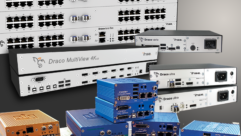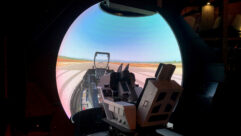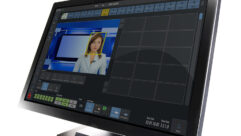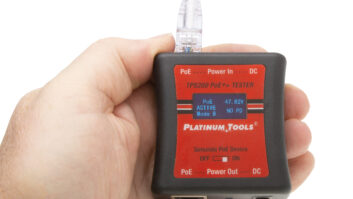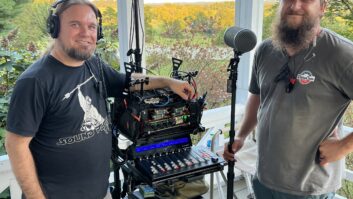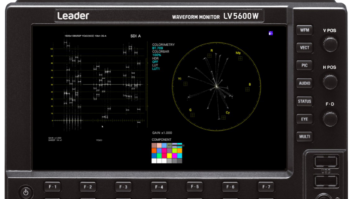
Technology Showcase:
System Processors: The Next Generation
Jan 1, 2005 12:00 PM,
By Linda Seid Frembes
Drag-and-drop signal flow design, multiple functions, and CobraNet compatibility mark many of today’s DSPs.
Since the beginning of audio systems, there has been some sort of systems processing included. Sure, the actual entity doing the processing has taken on many different forms; and the design of such systems was either conceived on a cocktail napkin in the wee hours after a day on the tradeshow floor or formally drawn out on drafting paper and presented to the end user.
QSC Audio’s QSControl.net.
Fast forward to today, and you will notice that a new generation of system processors has replaced pen and paper design methods with a mouse and a computer.
For this month’s showcase, our focus is on these software-driven system processors. These processing platforms offer drag-and-drop signal flow design capabilities, are multifunctional (i.e., can also act as your mixer, router, compressor, equalizer, crossover, and kitchen sink), and in some instances are CobraNet compatible.
Perhaps most importantly, this next generation of systems processors is easily and infinitely scalable. Each manufacturer’s processing platform includes several different processing units that can fit almost any budget or application. For that reason, I have chosen not to focus on a particular price point in this showcase, rather to highlight the different options and technologies in this market category.
For easy reading, each processing platform is listed alphabetically by manufacturer:

Ashly Protea 24.24M Matrix Processor
ASHLY PROTEA 24.24M MATRIX PROCESSOR
Ashly Audio, best known for its reliable processors, has added to its popular Protea System II product line with the release of the Protea 24.24M digital processor. The Protea 24.24M Matrix processor uses modular expansion cards to provide up to 24 channels of audio matrixing and processing.
“A unique feature native to the Protea 24.24M is that each of its input or output modules includes its own DSP. This allows the base 4×4 product to be fully functional and cost effective, as it does not carry the burden of DSP for all of the expansion slots,” explains Stephen Siegel, director of engineering for Ashly. “This modularity allows the product configuration to vary, depending on the intended use. You can expand the base unit’s total inputs or outputs four channels at a time.”
These modular expansion cards are easily installed in the field without the need to reprogram the Protea 24.24.M. Matrixing allows routing to any I/O with level control at each cross point. All programming is accomplished using Ashly’s Protea System Software on a PC platform. The absence of front panel controls, coupled with multi-level software security, ensures a tamperproof audio system. The Protea platform’s fixed path architecture and extensive processing power per channel reduce the amount of time it takes to set up the system.
Factory presets for distributed or conventional sound applications are provided as a starting point for users to set customized system requirements, and these may be overwritten, copied, or saved to separate preset locations. For the installation market, Ashly offers three accessory wall mount remote controls that allow for level control, preset recall, mute groups, and other functions.
BIAMP SYSTEMS AUDIA
Drawing on its long experience in designing audio electronics, Biamp Systems has channeled that knowledge into the mixing, EQ, dynamics processors, and additional functionality that are incorporated in its Audia family of digital audio products. Biamp Systems was one of the first audio companies in the installed marketplace to offer products programmed with PCs. The company knew that in the near future, designers and systems integrators would want to use a PC to design and remotely control audio systems. The Audia system relies on Windows to make its software intuitive.
“It was evident to us that open architecture products were the future of the installed audio industry. In order to continue to be a major player in the installed industry, we needed to provide a product with this type of functionality,” said Graeme Harrison, Biamp’s vice president of international sales.
The Audia product line includes AudiaFLEX, which offers24 customizable input/output slots (in blocks of two); and AudiaSOLO, a 1U box that offers all of the Audia processing power and three I/O options in a single rack space. Additional system flexibility and design are achieved using either analog or digital AudiaEXPI and AudiaEXPO I/O expanders. The Audia platform offers many current design features, including Ethernet control, CobraNet audio networking, and copious amounts of DSP, allowing for more DSP-intensive algorithms to be included if necessary.
Biamp’s Audia platform is suitable for small-, medium-, or large-scale audio or AV applications, including theaters, convention centers, houses of worship, and stadiums.
Since the launch of Audia in 2002, Biamp has introduced additional features and products to widen its appeal. In 2003, the company introduced remote controls, AudiaFLEX, AudiaSOLO, AudiaEXPI, AudiaEXPO, and AEC2 Input Cards (acoustical echo canceling). In 2004, Biamp introduced the TI2 (telephone hybrid), the digital versions of EXPI and EXPO, and the Event Scheduler.

BSS Soundweb London
BSS AUDIO SOUNDWEB LONDON
Soundweb by BSS is an integrated, programmable DSP system with control and audio networking on a single Cat 5 cable. BSS Audio recently added to its successful line of Soundweb products by introducing Soundweb London. This product is a third-generation DSP that evolved from preceding products such as Omnidrive and the original Soundweb.
“Soundweb was developed in response to the market need for a more flexible, cost-effective solution to signal processing and management. Looking at existing products, BSS Audio recognized that a networked, fully assignable and distributed DSP solution would give the user the flexibility, control, and cost-savings necessary,” said Iain Gregory, product manager for BSS.
BSS Audio worked closely with its sister Harman companies towards central control and monitoring of integrated systems. For example, Crown Audio’s PIP-LITE, USP3, and USP3-CN PIP modules can now be controlled and monitored using London Architect.
Both the original Soundweb Designer and the new London Architect software are free-form, as opposed to having a fixed-path layout. The Soundweb processing platform offers very low audio latency and a comprehensive choice of control methods, including PC control, analog control, programmable digital remote control, and serial control. Soundweb can be configured to select in realtime among different processing layouts for flexibility at different events.
The mainstay of the Soundweb London system is the BLU-80 signal processor. The BLU-80 can accept four input or output cards. This means that a BLU-80 can be easily configured at base or in the field to provide a wide variety of I/O configurations.
Like other products in this market segment, Soundweb offers a plethora of presets and configurations for small, medium, and large applications. Facility users range from houses of worship to sports arenas, performing arts centers, conference centers, ballrooms, cruise ships, and museums.
“Although primarily an installation product, Soundweb has been widely adopted by rental companies for audio distribution and processing in concert touring,” Gregory says. “A system can be programmed and tested in the rental company warehouse and then, if necessary, the Sound-web design file can be emailed across the world to a similar rack of equipment for a different leg of the tour.”
DBX DRIVERACK 220I
The DriveRack 220i from dbx provides both mic and loudspeaker system processing, with features including Advanced Feedback Suppression (AFS), graphic and parametric EQ, and dynamics processing. The system is controlled via RS232 (with access on both the front and rear panel) on a Windows-based PC with the DriveRack GUI software. Accessories include wall mount zone controllers that can provide user-programmable controls such as level adjustment or system muting.
Suggested applications for the two-input, two-output DriveRack 220i are system processing (stereo or dual mono), background music or paging, room combining or microphone processing.

Lake Technology Lake Contour
LAKE TECHNOLOGY CONTOUR
Lake Technology’s Lake Contour processing platform has a heritage rooted in live sound mixing. Contour’s development began as a collaborative effort between David McGrath, co-founder of Lake Technology, and Bruce Jackson, founder of Apogee Electronics and formerly Elvis’ and Bruce Spring-steen’s sound engineer. The duo founded Clair LLC with other members from Lake and Clair Bros. to aid Clair Bros. in finding a solution for its loudspeaker system signal processing.
“Bruce’s ideas of walking the venue and listening, all the while making adjustments to the sound system, were coupled with David’s advanced signal processing expertise to result in what is now known as the Clair iO,” explains Justin Baird, director of product management at Lake Technology. “Through the development of the Clair iO came the foundation of the Contour.”
Released in March 2003, the Contour offers enhancements to both the Clair iO hardware and software, including a wireless touchscreen remote that allows the user to walk the venue and simultaneously make adjustments to the system; full network control across all processors via Ethernet; the Lake Mesa Filter that offers asymmetric filtering with the ability to separate the sides of a parametric section, change center frequencies, and adjust slopes independently; and integration with SmaartLive measurement that allows users to adjust EQ and view RTAs, spectrographs, and transfer functions at the same time.
Lake also recently released the Mesa Quad EQ, which is similar to the Contour but created for front-end signal processing. The Mesa Quad EQ provides four discrete channels of Lake’s EQ Overlay processing, with signal routing, delay, and dynamics capabilities.
The Lake Controller software provides a unified interface for Lake Contour and Lake Mesa Quad EQ processors. Using a touchscreen interface, the user can control a distributed network of processors from a single location. Instant adjustments can be made to any parameter of any processor on the network, or to selected groups of processors. The Lake Controller software runs on any Windows-based PC with a standard Ethernet network interface.
MEYER SOUND LABS
At the AES show last October, Meyer Sound introduced the Galileo 616 Loudspeaker management system. The system features a 6-input, 16-output digital matrix processor. Everything required to drive and align a multiple zone loudspeaker system is incorporated in the 2U rackmount package. Galileo can be operated as a stand-alone system directly from the frontpanel controls, or in conjunction with a personal computer (Windows or Mac) via Ethernet.
The system features a fixed latency regardless of processing applied. And A/D/A conversion is 24-bit resolution with sample rates up to 96kHz. There is 32-bit floating point processing for digital implementation of Meyer Sound processing features, including atmospheric compensation and filters from the company’s lineup of EQs.
PEAVEY MEDIAMATRIX NION
In 1993, the processor market was forever altered by the introduction of the first MediaMatrix product. Today, the Media Matrix brand spans a product line from basic audio processing to fully integrated and managed systems. Its newest product, NION, is a programmable digital audio processing node for professional and commercial audio and communications applications.
“The NION name applies to several different products of which the feature sets are universally applicable,” explains Will Roland, operations and creative services manager for MediaMatrix. “The new NION products offer much more processing power than the older platform. For NION, we used totally new DSP technology coupled with our high-quality audio algorithms and a more efficient architecture.”
The NION line relies on an Analog Devices SHARC Hammerhead DSP engine, and is currently available in two configurations: the NION n6 provides six SHARC DSPs, while the NION n3 provides three.
“Where the NION products really shine are from a design standpoint. The systems designer can put a NION node at any network drop to create any type of infrastructure required. The infrastructure can be centralized, distributed, or a hybrid of both, depending on the client’s needs,” said Roland. “As long as there is a network infrastructure, you can install a NION node.”
The NION system can be configured, managed, networked, and controlled from any computer on the network. NION offers low audio latency performance that typically approaches 2ms from analog input to analog output, higher sonic quality, and support for high sample rates.
The NION’s internal processing core has a range of features, including MediaMatrix’s scalable I/O architecture, a modular I/O scheme that supports optional plug-in cards. Four module bays support up to 32 simultaneous analog audio channels, while the integrated CobraNet port provides 64 channels for a total of 96 simultaneous configurable audio channels per NION node.
Additional support for third-party control and SNMP management tools is included. The front panel interface features an LCD display, soft buttons, and rotary encoder to allow access to common system functions. Additional interfacing is provided by both RS232 and RS485 ports.
QSC AUDIO QSCONTROL.NET
QSControl.net, QSC’s next-generation network audio system platform, was developed to combine the technologies of three QSC product types into a single processing platform. The QSControl.net product family includes the BASIS 922az, BASIS 904zz, 902zz, and RAVE 522aa units.
“QSControl.net is a unified system that combines several technologies offered by QSC — the configurable DSP for loudspeakers in our DSP 3, 4, and 30 products; the amplifier and loudspeaker management in our CM16a product; and the CobraNet connectivity with our RAVE products,” says Tim Van Grove, digital systems strategist/planner and product manager at QSC.
QSControl.net seamlessly integrates signal transport, control, processing, and monitoring technologies. QSC’s DSP engine is unique in having a short and fixed processing latency through the DSP subsystem, regardless of the number of processing blocks added. The Basis and new RAVE units also afford maximum flexibility in I/O configuration with configuration options up to 24×24.
The platform has been well accepted by stadiums and arenas, theme parks, houses of worship, and facilities with large areas that require DSP, amp management, and CobraNet. While designed for permanent installs, QSControl.net pro-ducts are also used with touring sound rigs. This portability is possible since QSControl.net allows the user to control the Basis and RAVE products from a single networked computer or multiple networked computers.
“Ethernet control of loudspeaker processing solves the problems that are created when amps and loudspeakers are spread out over a large area. We’ve been developing products in this area for some time,” Van Grove says.
With the QSControl.net platform, QSC is able to provide DSP, amplifier and loudspeaker management, and CobraNet all from a single hardware unit. While it is possible to do this with products from other manufacturers, only QSControl.net provides this capability in a single hardware unit.
RANE DRAG NET
With a motto like “Spend time designing systems, not learning software,” Rane’s Drag Net platform was developed with ease of use and intuitive features in mind. Drag Net’s WYSIWYG user interface includes six options: project, palette, device configuration, resource, preset, and metering.
Drag Net is a Windows-based application used to configure, control, and monitor the RPM series of six DSP-based products. Drag Net software supports from 2×2 up to 10×10 audio systems (depending on the RPM unit), all with standard 10Base-T Ethernet connectivity for PC to RPM.
“Drag Net’s most unique feature is the flexibility of its remotes,” says Steve Macatee, director of new product development and training at Rane. “The remotes make the user interface very simple and easy to operate, no matter what the application or skill level.”
Drag Net users can deploy multiple one gang, Decora-compatible remotes that are a simple one-knob and one-interface configuration to access multiple features.

SHURE P4800
Shure’s P4800 digital system processor is the marquee product for Shure’s DSP line. The P4800 is a 4×8 digital audio processor that can perform all the necessary functions between mixers and power amplifiers in small to medium-sized sound systems.

Shure P4800 (with software)
“The P4800’s development was a logical follow-up to our DFR11EQ feedback reducer,” explains Bob Rieder, category director of commercial audio products at Shure. “We developed the P4800 to make it easier for system designers who aren’t completely comfortable with computers to take advantage of the versatility of integrated digital audio processors.”
With the P4800, Shure has forged the middle ground in software design, offering a flexible PC interface that combines the best features of preconfigured templates and CAD-style design programs. Using this drag-and-drop graphical user interface, the P4800’s processing blocks can be placed anywhere in the signal path. The 4×8 matrix mixer allows any or all inputs to be routed to any or all outputs with controls for sensitivity, gain, and polarity.
Because of its flexibility, the P4800 is appropriate for a wide range of uses. The P4800 has been well received in the house of worship market, educational facilities, and in live performance theaters. The 4×8 line-level I/O configuration is intended to be used with one or more outboard mixers.
“For example, you can run speech microphones though an automixer to one input, and feed the other three inputs from a main music console,” explains Rieder.
In at least one installation of this type, the designer incorporated contact switches so that the P4800 would normally work with the automixer alone, but would automatically switch to operation with both mixers when the console cover was removed.
The P4800 will store up to 128 preset configurations that can be recalled using simple contact closures, MIDI, or RS232 commands. Another feature is the P4800’s ability to autosave its presets. In the event of a power loss, the unit will reboot to exactly the same condition.
“The P4800 is also a great retrofit piece if you need a back-end processor for other equipment that you’d like to continue to use in an existing system,” says Rieder.
SYMETRIX AUDIO SYMNET
The Symetrix SymNet Audio Matrix is a family of network-linkable audio matrix DSP devices. The SymNet platform provides for flexibility of hardware devices as well as SymNet’s 64-channel bus, efficient DSP coding and fanatical factory support. SymNet was developed in response to the processor market trend toward multi-function DSP devices whose capability would far exceed a rack full of discrete processors.
Based on that research, Symetrix introduced its SymNet Express series. Available in two hardware versions, Express and Express Cobra, these processors are driven by version 5 of SymNet Designer. This software allows offline creation and adjustment of Express audio processing from a desktop, and realtime control. Among the new Express series features are an onboard Ethernet interface so Express units can be mounted on a computer network (LAN) and accessed remotely in realtime.
Express Cobra is available in four models: 12×4, 4×12, 8×8, and 4×4. Each includes an 8×8 CobraNet license, supporting the industry standard protocol for networked digital audio. Express continues to rely on Analog Devices SHARC floating point DSP chips for its audio processing engine. Each unit includes two 100MHz processors capable of running the full gamut of Symetrix tools, such as automixers, compressor/limiters, Feedback Fighters, and matrix mixers.
A LOOK AT THE NEXT, NEXT GENERATION
The next new wave for these super multi-processors is greater flexibility in networking and the continued convergence of IT and AV. Almost every magazine has covered convergence more than once this year and that trend will likely continue. It will become an ever bigger topic as manufacturers find new and better ways to go digital. And, spurred by alternate Windows technologies like Linux, our industry could see more of a migration toward open architecture products that will even further expand the ability to design whatever system your clients (or you) can dream up.
And finally, is RS232 dead? A few years ago, it was a common feature for systems processors. Today, most manufacturers are touting Ethernet capabilities. Since most of today’s desktop computers and laptops no longer offer RS232 connections as the standard, perhaps we are experiencing an evolution to all things Ethernet. Again, the connection issue is one of the IT and AV communities merging and evolving.
For More Information
Ashlywww.ashly.com
Biampwww.biamp.com
Lake Technologieswww.lake.com.au
Meyer Soundwww.meyersound.com
Peavey MediaMatrixmediamatrix.peavey.com
Ranewww.rane.com
Shurewww.shure.com
Symetrixwww.symetrixaudio.com
Linda Seid Frembesis a freelance writer and public relations specialist for the AV industry. Her spot in the digital revolution can be found atwww.frembes.com.


